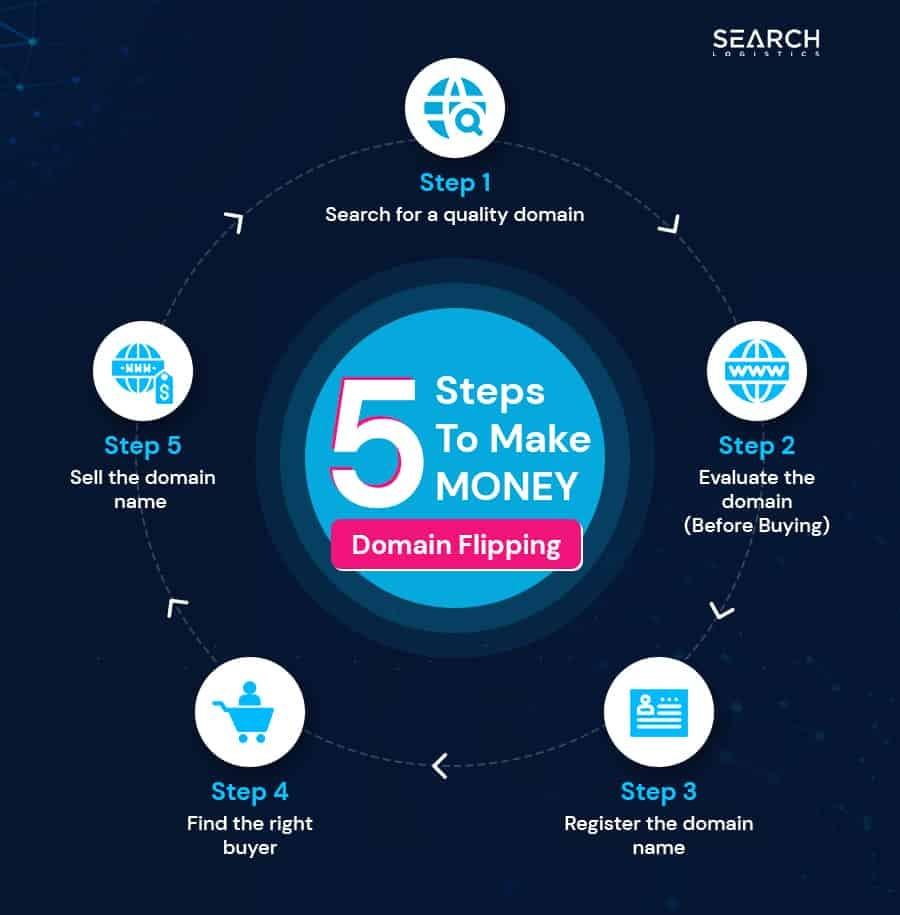Table of Contents
- Exploring the Basics of Domain Flipping for New Investors
- Key Strategies for Identifying Valuable Domain Names
- Marketing Your Domains Effectively to Maximize Profits
- Navigating Domain Valuation Techniques and Tools
- Building a Sustainable Portfolio: Tips for Long-Term Success
- Q&A
- In Conclusion


Exploring the Basics of Domain Flipping for New Investors
Domain flipping is an intriguing venture for new investors looking to tap into online real estate. At its core, this practice involves purchasing domain names at a lower price and selling them at a profit. By understanding the nuances of market trends, one can identify undervalued domains that have the potential for significant appreciation. Factors such as keyword relevance, length, and target demographic play crucial roles in determining a domain’s value. New investors should familiarize themselves with tools and platforms that help analyze these elements to make informed purchasing decisions.
To effectively navigate the domain flipping landscape, it’s essential to consider the following strategies:
- Research & Data Analysis: Utilize tools like Google Trends and keyword planners to find popular terms.
- Marketplace Evaluation: Explore established marketplaces such as Sedo and Flippa to gauge current selling prices.
- Brandability: Look for domains that are not only relevant but also easy to remember and spell.
As beginners embark on this journey, understanding the financial aspects is equally important. Below is a simple breakdown of potential costs associated with domain flipping:
| Cost Type | Estimated Amount |
|---|---|
| Domain Registration Fees | $10 – $20/year |
| Marketplace Listing Fees | $5 – $100 |
| Renewal Fees | $10 – $20/year |
By acutely understanding these costs, aspiring domain flippers can better plan their purchases and sales, ultimately driving towards profitability.
Key Strategies for Identifying Valuable Domain Names
Identifying domain names with high potential can significantly impact the success of your domain flipping endeavors. Start by focusing on keyword-rich phrases that resonate with various audiences. Evaluate trends in your target market using tools like Google Trends or keyword planners to find popular search terms. It’s essential to select a name that effectively encapsulates its niche to attract more traffic and buyers. Additionally, consider utilizing long-tail keywords, as they can improve search engine visibility and lead to higher conversions.
Another crucial factor is the length and simplicity of the domain name. Short, memorable names are often more successful, as they are easier for users to recall and share. Aim for domains consisting of 1 to 3 words, ideally without hyphens or numbers. Also, an effective approach is to conduct a competitor analysis: examine which domain names in your niche are performing well and consider how you can create a name that offers similar or greater appeal.
Lastly, the .com extension remains the most trusted and recognized by consumers. While other extensions like .net or .org can be valuable, they often don’t carry the same weight. However, regional extensions may offer potential in specific markets. Analyzing historical sales data can provide insights into which extensions typically yield higher returns. Here’s a quick summary comparing popular TLDs:
| Extension | Market Perception | Typical Sale Prices |
|---|---|---|
| .com | Highly trusted | High |
| .net | Less common but reputable | Medium |
| .org | Nonprofit or community-based | Medium |
| .co | Startups and brands | Medium to High |
| Regional TLDs (.uk, .ca) | Localized trust | Varied |


Marketing Your Domains Effectively to Maximize Profits
When it comes to flipping domains, the foundation of your profits lies in how effectively you market them. Start by showcasing the unique features and potential of each domain. Highlight its keyword relevancy, SEO potential, and any pre-existing traffic metrics. Use professional imagery and engaging language to create a compelling listing on platforms like Sedo or Flippa. This will not only draw attention but also establish credibility with potential buyers.
Utilizing social media to promote your domains can significantly increase visibility. Create targeted campaigns that leverage platforms such as Twitter, LinkedIn, and Facebook. Here are some strategies to implement:
- Join relevant groups focused on digital entrepreneurship and domain trading.
- Share insightful content related to domain investment trends to establish yourself as an authority.
- Use hashtags like #DomainFlipping and #DomainInvesting to reach a wider audience.
don’t overlook the value of email marketing in reaching potential buyers. Develop a curated list of investors, collectors, and businesses that may benefit from your domains. Craft personalized messages that detail why the domains are valuable investments. Consider utilizing an email newsletter to keep your audience informed about your latest acquisitions or success stories. This consistent engagement can lead to increased interest and higher selling prices.


Navigating Domain Valuation Techniques and Tools
When delving into domain valuation, understanding various techniques and tools is critical for determining the true worth of a domain name. One of the most commonly used methods is the comparative sales analysis, where you assess similar domain sales to gauge market value. Additionally, employing tools like GoDaddy Domain Appraisal or NameBio can provide insights based on recent sales data and market trends. These resources can dramatically influence your buying and selling strategy, providing a quantitative basis for your domain valuation decisions.
Another essential approach is the income potential evaluation. This involves estimating how much revenue a domain could generate, particularly if it’s associated with existing businesses or offers specific services. You might consider metrics such as traffic statistics, industry demand, and even organic search rankings. Utilizing tools like SEMrush or Ahrefs can offer invaluable data concerning estimated traffic and potential earnings, making it easier to assign a realistic price to a domain.
Furthermore, it’s important to understand the role of brandability and length in determining a domain’s value. Short, memorable domains that resonate with a target audience often command higher prices. An appealing way to appraise brand potential is by utilizing online tools like LeanDomainSearch or Namechk, which not only help in finding available alternatives but also assess the marketability of a domain name. For a clearer overview, consider this simple valuation criteria table:
| Criteria | Importance |
|---|---|
| Length of the Domain | High |
| Keyword Relevance | Medium |
| Market Demand | High |
| Extension Type (.com, .net, etc.) | High |
| Brandability | High |


Building a Sustainable Portfolio: Tips for Long-Term Success
When diving into the world of domain flipping, it’s essential to adopt a strategic mindset that mirrors sustainable investment principles. This involves thorough research into domain trends and the broader online landscape. By identifying niches that show potential for growth, buyers can secure domains that not only hold current value but also appreciate over time. Tools like Google Trends and keyword research platforms can assist in pinpointing valuable domain names that align with emerging market demands.
Liquidity is a critical factor when building a successful portfolio. Domains should cater to specific industries or interests that have a solid buyer base. Consider investing in premium TLDs (Top-Level Domains) such as .com or niche-specific extensions like .tech or .design, which often yield higher resale prices. Additionally, creating multifaceted listings that incorporate SEO best practices can boost visibility and attract more potential buyers:
- Utilize high-impact keywords.
- Develop engaging content around each domain.
- Leverage social media channels to showcase available domains.
Diversifying your portfolio can also mitigate risks. By investing in a variety of domain types—such as short domains, generic keywords, and brandable names—you increase your chances of profit across different segments. Below is a simple framework for assessing potential domains before purchase:
| Domain Type | Criteria | Potential Resale Value |
|---|---|---|
| Brandable | Easy to remember, unique | High |
| Keyword | Search volume, SEO value | Medium to High |
| Short | Less than 10 characters | Very High |
Q&A
Q&A on Domain Flipping Books
Q1: What is domain flipping? A1: Domain flipping refers to the practice of buying domain names at a lower price and selling them at a profit. This business model capitalizes on the demand for specific domain names that align with current trends, business endeavors, or keywords that attract internet traffic.Q2: What can I expect to learn from a domain flipping book? A2: A well-crafted domain flipping book will provide insights into key aspects such as identifying valuable domain names, effective purchasing strategies, market research techniques, and how to successfully sell domains for a profit. Additionally, you’ll often find case studies and practical tips from experienced flippers.
Q3: Are there any recommended books for beginners in domain flipping? A3: Absolutely! Popular choices include “Domain Flipping: The Ultimate Guide to Buying and Selling Domains” and “Flippa: The Ultimate Guide to Buying and Selling Websites.” These titles often cover the fundamentals, market dynamics, and provide actionable strategies tailored for newcomers.
Q4: Is domain flipping a risky investment? A4: Like any investment, domain flipping carries its risks. The value of a domain can fluctuate based on market trends and buyer interest. However, with thorough research and strategic planning, you can mitigate these risks and increase your chances of a profitable sale.
Q5: What should I look for when choosing a domain name to flip? A5: Ideal domain names are typically short, easy to remember, and have relevant keywords. Look for names that are brandable and have an existing search volume. Additionally, finding expired domains with pre-established authority can be a significant advantage.
Q6: How long does it usually take to sell a domain? A6: The selling timeline can vary widely. Some domains may sell within days or weeks based on demand and marketing efforts, while others may take months to find the right buyer. Patience and persistence are essential in the domain flipping business.
Q7: Do I need any special skills to start flipping domains? A7: While specialized skills aren’t necessary, having a good understanding of market trends, SEO principles, and online marketing can be beneficial. Additionally, basic negotiation skills can help you secure better deals when buying or selling domains.
Q8: Can I flip domains without a large initial investment? A8: Yes, domain flipping can be started with a modest budget. You can look for expired or undervalued domains that have a good potential for resale. Focusing on clever strategies rather than high-end purchases can yield great results.
Q9: How can I market my domain effectively? A9: Effective marketing strategies include listing your domain on popular marketplaces like Flippa or Sedo, using social media to promote your domain, and reaching out to potential buyers directly via email. Crafting compelling descriptions and demonstrating the value of the domain can also enhance your chances of a successful sale.
Q10: Are there any online communities or resources for aspiring domain flippers? A10: Yes, there are numerous forums and online communities where domainers share tips, experiences, and advice. Websites like NamePros and DNForum offer valuable insights, while social media groups can facilitate networking and collaboration among domain flippers. — By diving into the world of domain flipping and reading informative books on the subject, you can equip yourself with the necessary knowledge to thrive in this fascinating digital marketplace. Happy flipping!

